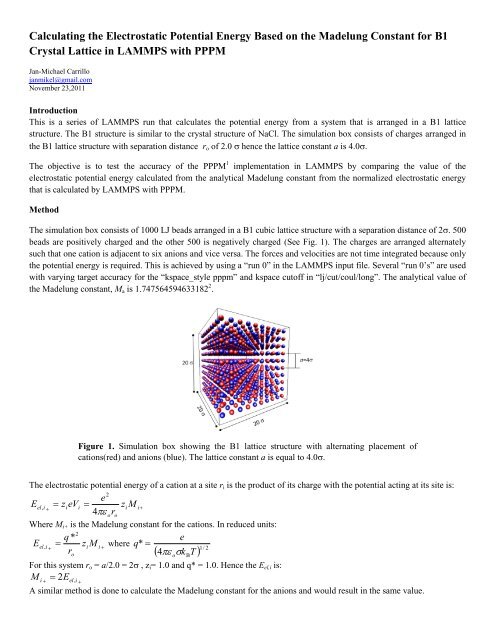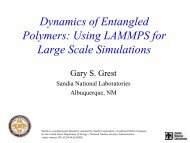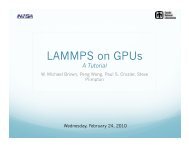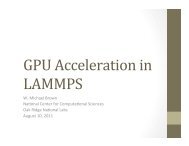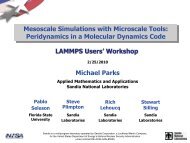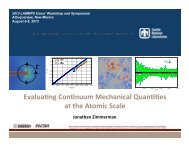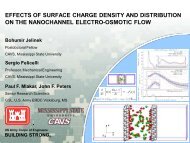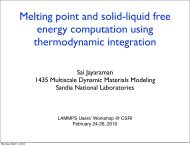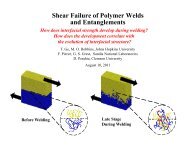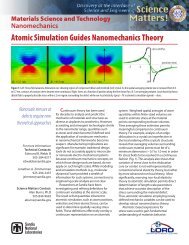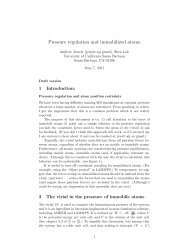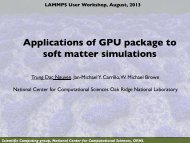Calculating the Electrostatic Potential Energy Based on ... - Lammps
Calculating the Electrostatic Potential Energy Based on ... - Lammps
Calculating the Electrostatic Potential Energy Based on ... - Lammps
Create successful ePaper yourself
Turn your PDF publications into a flip-book with our unique Google optimized e-Paper software.
<str<strong>on</strong>g>Calculating</str<strong>on</strong>g> <str<strong>on</strong>g>the</str<strong>on</strong>g> <str<strong>on</strong>g>Electrostatic</str<strong>on</strong>g> <str<strong>on</strong>g>Potential</str<strong>on</strong>g> <str<strong>on</strong>g>Energy</str<strong>on</strong>g> <str<strong>on</strong>g>Based</str<strong>on</strong>g> <strong>on</strong> <str<strong>on</strong>g>the</str<strong>on</strong>g> Madelung C<strong>on</strong>stant for B1<br />
Crystal Lattice in LAMMPS with PPPM<br />
Jan-Michael Carrillo<br />
janmikel@gmail.com<br />
November 23,2011<br />
Introducti<strong>on</strong><br />
This is a series of LAMMPS run that calculates <str<strong>on</strong>g>the</str<strong>on</strong>g> potential energy from a system that is arranged in a B1 lattice<br />
structure. The B1 structure is similar to <str<strong>on</strong>g>the</str<strong>on</strong>g> crystal structure of NaCl. The simulati<strong>on</strong> box c<strong>on</strong>sists of charges arranged in<br />
<str<strong>on</strong>g>the</str<strong>on</strong>g> B1 lattice structure with separati<strong>on</strong> distance r o of 2.0 hence <str<strong>on</strong>g>the</str<strong>on</strong>g> lattice c<strong>on</strong>stant a is 4.0.<br />
The objective is to test <str<strong>on</strong>g>the</str<strong>on</strong>g> accuracy of <str<strong>on</strong>g>the</str<strong>on</strong>g> PPPM 1 implementati<strong>on</strong> in LAMMPS by comparing <str<strong>on</strong>g>the</str<strong>on</strong>g> value of <str<strong>on</strong>g>the</str<strong>on</strong>g><br />
electrostatic potential energy calculated from <str<strong>on</strong>g>the</str<strong>on</strong>g> analytical Madelung c<strong>on</strong>stant from <str<strong>on</strong>g>the</str<strong>on</strong>g> normalized electrostatic energy<br />
that is calculated by LAMMPS with PPPM.<br />
Method<br />
The simulati<strong>on</strong> box c<strong>on</strong>sists of 1000 LJ beads arranged in a B1 cubic lattice structure with a separati<strong>on</strong> distance of 2. 500<br />
beads are positively charged and <str<strong>on</strong>g>the</str<strong>on</strong>g> o<str<strong>on</strong>g>the</str<strong>on</strong>g>r 500 is negatively charged (See Fig. 1). The charges are arranged alternately<br />
such that <strong>on</strong>e cati<strong>on</strong> is adjacent to six ani<strong>on</strong>s and vice versa. The forces and velocities are not time integrated because <strong>on</strong>ly<br />
<str<strong>on</strong>g>the</str<strong>on</strong>g> potential energy is required. This is achieved by using a “run 0” in <str<strong>on</strong>g>the</str<strong>on</strong>g> LAMMPS input file. Several “run 0’s” are used<br />
with varying target accuracy for <str<strong>on</strong>g>the</str<strong>on</strong>g> “kspace_style pppm” and kspace cutoff in “lj/cut/coul/l<strong>on</strong>g”. The analytical value of<br />
<str<strong>on</strong>g>the</str<strong>on</strong>g> Madelung c<strong>on</strong>stant, M a is 1.747564594633182 2 .<br />
Figure 1. Simulati<strong>on</strong> box showing <str<strong>on</strong>g>the</str<strong>on</strong>g> B1 lattice structure with alternating placement of<br />
cati<strong>on</strong>s(red) and ani<strong>on</strong>s (blue). The lattice c<strong>on</strong>stant a is equal to 4.0.<br />
The electrostatic potential energy of a cati<strong>on</strong> at a site r i is <str<strong>on</strong>g>the</str<strong>on</strong>g> product of its charge with <str<strong>on</strong>g>the</str<strong>on</strong>g> potential acting at its site is:<br />
2<br />
e<br />
Eel,<br />
i<br />
z <br />
ieVi<br />
ziM<br />
i<br />
4<br />
oro<br />
Where M i+ is <str<strong>on</strong>g>the</str<strong>on</strong>g> Madelung c<strong>on</strong>stant for <str<strong>on</strong>g>the</str<strong>on</strong>g> cati<strong>on</strong>s. In reduced units:<br />
2<br />
q *<br />
e<br />
Eel,<br />
i<br />
z<br />
iM<br />
i<br />
where q* <br />
<br />
r<br />
4 k T<br />
1/<br />
o<br />
<br />
o<br />
2<br />
For this system r o = a/2.0 = 2 , z i = 1.0 and q* = 1.0. Hence <str<strong>on</strong>g>the</str<strong>on</strong>g> E el,i is:<br />
2<br />
M i<br />
E<br />
el , i <br />
B<br />
A similar method is d<strong>on</strong>e to calculate <str<strong>on</strong>g>the</str<strong>on</strong>g> Madelung c<strong>on</strong>stant for <str<strong>on</strong>g>the</str<strong>on</strong>g> ani<strong>on</strong>s and would result in <str<strong>on</strong>g>the</str<strong>on</strong>g> same value.
M i<br />
2 E<br />
el , i <br />
For an i<strong>on</strong>ic solid, <str<strong>on</strong>g>the</str<strong>on</strong>g> sum of c<strong>on</strong>tributi<strong>on</strong>s of cati<strong>on</strong>s and ani<strong>on</strong>s of a crystal would <str<strong>on</strong>g>the</str<strong>on</strong>g>n be <str<strong>on</strong>g>the</str<strong>on</strong>g> sum of <str<strong>on</strong>g>the</str<strong>on</strong>g> partial<br />
Madulung c<strong>on</strong>stants of cati<strong>on</strong> and ani<strong>on</strong> subarrays 3 . Hence <str<strong>on</strong>g>the</str<strong>on</strong>g> total Madelung c<strong>on</strong>stant is,<br />
M<br />
a<br />
M<br />
i<br />
M<br />
i<br />
2 E<br />
el , i<br />
+ 2 E<br />
el ,<br />
= 4E i el , i<br />
where E<br />
el , i<br />
would be <str<strong>on</strong>g>the</str<strong>on</strong>g> normalize potential energy that will be outputted by<br />
LAMMPS.<br />
Thus, in order to compare <str<strong>on</strong>g>the</str<strong>on</strong>g> results of <str<strong>on</strong>g>the</str<strong>on</strong>g> “run 0” LAMMPS run with <str<strong>on</strong>g>the</str<strong>on</strong>g> analytical expected value of <str<strong>on</strong>g>the</str<strong>on</strong>g> electrostatic<br />
energy, we should divide <str<strong>on</strong>g>the</str<strong>on</strong>g> analytical Madelung c<strong>on</strong>stant, M a by 4 ( E M / 4 ). The expected normalized<br />
electrostatic potential energy up to 15 decimal places is 0.436891148658295 k B T.<br />
el, i , analytical a<br />
Results and Discussi<strong>on</strong>s<br />
Table 1 shows <str<strong>on</strong>g>the</str<strong>on</strong>g> target accuracy value, <str<strong>on</strong>g>the</str<strong>on</strong>g> LAMMPS potential energy output from different near field cutoffs, <str<strong>on</strong>g>the</str<strong>on</strong>g><br />
absolute value of <str<strong>on</strong>g>the</str<strong>on</strong>g> difference of <str<strong>on</strong>g>the</str<strong>on</strong>g> between <str<strong>on</strong>g>the</str<strong>on</strong>g> LAMMPS calculated energy to <str<strong>on</strong>g>the</str<strong>on</strong>g> electrostatic potential energy<br />
calculated from <str<strong>on</strong>g>the</str<strong>on</strong>g> Madelung c<strong>on</strong>stant and <str<strong>on</strong>g>the</str<strong>on</strong>g> estimated RMS 4 calculated by LAMMPS.<br />
Table 1<br />
Target<br />
Accuracy<br />
Cutoff = 6 Cutoff = 8 Cutoff = 10<br />
RMS<br />
E<br />
el , i<br />
E<br />
* RMS el , i<br />
E<br />
* RMS el , i<br />
*<br />
1.00E-01 5.641E-02 0.316353 4.523E-02 4.886E-02 0.35422 8.267E-02 5.082E-02 0.391665 4.523E-02<br />
5.00E-02 3.221E-02 0.373343 1.780E-02 2.323E-02 0.40338 3.351E-02 2.495E-02 0.419089 1.780E-02<br />
1.00E-02 4.414E-03 0.429696 8.856E-04 1.922E-03 0.43504 1.851E-03 2.243E-03 0.436006 8.856E-04<br />
5.00E-03 2.896E-03 0.432315 8.856E-04 1.922E-03 0.43504 1.851E-03 2.243E-03 0.436006 8.856E-04<br />
1.00E-03 5.097E-04 0.436167 1.091E-04 3.311E-04 0.43664 2.507E-04 3.947E-04 0.436782 1.091E-04<br />
5.00E-04 2.254E-04 0.436584 6.252E-05 3.311E-04 0.43664 2.507E-04 2.467E-04 0.436829 6.252E-05<br />
1.00E-04 6.156E-05 0.436812 7.524E-06 5.331E-05 0.436859 3.200E-05 3.966E-05 0.436884 7.524E-06<br />
5.00E-05 3.620E-05 0.436845 5.424E-06 3.315E-05 0.436872 1.880E-05 2.965E-05 0.436886 5.424E-06<br />
1.00E-05 6.240E-06 0.436883 7.487E-07 5.404E-06 0.436889 2.449E-06 4.833E-06 0.43689 7.487E-07<br />
5.00E-06 3.702E-06 0.436887 6.237E-07 4.060E-06 0.436889 1.799E-06 4.033E-06 0.436891 6.237E-07<br />
1.00E-06 7.861E-07 0.43689 1.237E-07 9.035E-07 0.436891 3.487E-07 8.080E-07 0.436891 1.237E-07<br />
<br />
*<br />
E<br />
el,<br />
i<br />
M<br />
<br />
4<br />
c rystal
Figure 2. Dependence of to <str<strong>on</strong>g>the</str<strong>on</strong>g> target accuracy (a) and dependence of to <str<strong>on</strong>g>the</str<strong>on</strong>g> estimated<br />
RMS value (b) for a simulati<strong>on</strong> box with reduced density, =0.125 -3 and lattice<br />
c<strong>on</strong>stant,a=4.<br />
Figure 2 summarizes <str<strong>on</strong>g>the</str<strong>on</strong>g> results tabulated in Table 1. A similar simulati<strong>on</strong> run is d<strong>on</strong>e for a box that is 101010 3 . This<br />
is to see <str<strong>on</strong>g>the</str<strong>on</strong>g> effect of density in <str<strong>on</strong>g>the</str<strong>on</strong>g> PPPM calculati<strong>on</strong> of <str<strong>on</strong>g>the</str<strong>on</strong>g> electrostatic potential energy. The results for this run are<br />
shown in figure 3.<br />
Figure 3. Dependence of to <str<strong>on</strong>g>the</str<strong>on</strong>g> target accuracy for a simulati<strong>on</strong> box with reduced density,<br />
=1.0 -3 and lattice c<strong>on</strong>stant,a=2.<br />
The implementati<strong>on</strong> of PPPM in LAMMPS can correctly recover <str<strong>on</strong>g>the</str<strong>on</strong>g> electrostatic potential energy based <strong>on</strong> <str<strong>on</strong>g>the</str<strong>on</strong>g> Madelung<br />
c<strong>on</strong>stant. For a system with a reduced density of 0.125 -3 , <str<strong>on</strong>g>the</str<strong>on</strong>g> near field cutoff of 10 has <str<strong>on</strong>g>the</str<strong>on</strong>g> least value of (error) and<br />
specifying a target accuracy of 1x10 -4 in <str<strong>on</strong>g>the</str<strong>on</strong>g> “kspace_style” argument results in an error or in <str<strong>on</strong>g>the</str<strong>on</strong>g> order of 1x10 -5 for<br />
<str<strong>on</strong>g>the</str<strong>on</strong>g> electrostatic potential energy.<br />
To comment <strong>on</strong> <str<strong>on</strong>g>the</str<strong>on</strong>g> probable result for more dense systems, when <str<strong>on</strong>g>the</str<strong>on</strong>g>re are more neighboring particles, this result might<br />
reverse and a near field cutoff that is less than 10 might get a lower value of . The reas<strong>on</strong> for this is <str<strong>on</strong>g>the</str<strong>on</strong>g>re would be<br />
more c<strong>on</strong>tributi<strong>on</strong> to <str<strong>on</strong>g>the</str<strong>on</strong>g> potential energy that is calculated in real space as opposed to <str<strong>on</strong>g>the</str<strong>on</strong>g> inverse space. For <str<strong>on</strong>g>the</str<strong>on</strong>g> system<br />
with reduced density of 1.0 -3 , <str<strong>on</strong>g>the</str<strong>on</strong>g> near field cutoff of 8 has <str<strong>on</strong>g>the</str<strong>on</strong>g> least value of (error) as shown in figure 3. The user is
advised to check what is <str<strong>on</strong>g>the</str<strong>on</strong>g> optimal near field cutoff for <str<strong>on</strong>g>the</str<strong>on</strong>g> desired error in <str<strong>on</strong>g>the</str<strong>on</strong>g> potential energy calculati<strong>on</strong> for a given<br />
system before proceeding to do producti<strong>on</strong> runs. For inhomogeneous systems, e.g. interfaces, a test run is str<strong>on</strong>gly<br />
advised. Fur<str<strong>on</strong>g>the</str<strong>on</strong>g>rmore, specifying very small target accuracy is computati<strong>on</strong>ally expensive and <str<strong>on</strong>g>the</str<strong>on</strong>g> user is advised to find<br />
<str<strong>on</strong>g>the</str<strong>on</strong>g> best value for <str<strong>on</strong>g>the</str<strong>on</strong>g> near field cutoff with respect to desired accuracy and simulati<strong>on</strong> time.<br />
C<strong>on</strong>clusi<strong>on</strong>s<br />
The implementati<strong>on</strong> of PPPM in LAMMPS can correctly recover <str<strong>on</strong>g>the</str<strong>on</strong>g> electrostatic potential energy based <strong>on</strong> <str<strong>on</strong>g>the</str<strong>on</strong>g> Madelung<br />
c<strong>on</strong>stant. For a system with a reduced density of 0.125 -3 , <str<strong>on</strong>g>the</str<strong>on</strong>g> near field cutoff of 10 has <str<strong>on</strong>g>the</str<strong>on</strong>g> least value of (error) and<br />
specifying a target accuracy of 1x10 -4 in <str<strong>on</strong>g>the</str<strong>on</strong>g> “kspace_style” argument results in an error or in <str<strong>on</strong>g>the</str<strong>on</strong>g> order of 1x10 -5 for<br />
<str<strong>on</strong>g>the</str<strong>on</strong>g> electrostatic potential energy. For <str<strong>on</strong>g>the</str<strong>on</strong>g> more dense system, <str<strong>on</strong>g>the</str<strong>on</strong>g> system with reduced density of 1.0 -3 , <str<strong>on</strong>g>the</str<strong>on</strong>g> near field<br />
cutoff of 8 has <str<strong>on</strong>g>the</str<strong>on</strong>g> least value of (error). The user is advised to check what is <str<strong>on</strong>g>the</str<strong>on</strong>g> optimal near field cutoff with respect<br />
to <str<strong>on</strong>g>the</str<strong>on</strong>g> desired error in <str<strong>on</strong>g>the</str<strong>on</strong>g> potential energy and <str<strong>on</strong>g>the</str<strong>on</strong>g> simulati<strong>on</strong> time for a given system before proceeding to do producti<strong>on</strong><br />
runs.<br />
References<br />
1. Hockney, R. W.; Eastwood, J. W., Computer simulati<strong>on</strong> using particles. Special student ed.; A. Hilger: Bristol<br />
[England] ; Philadelphia, 1988; p xxi, 540 p.<br />
2. Crandall, R. E.; Buhler, J. P., Elementary functi<strong>on</strong> expansi<strong>on</strong>s for Madelung c<strong>on</strong>stants. Journal of Physics A:<br />
Ma<str<strong>on</strong>g>the</str<strong>on</strong>g>matical and General 1987, 20 (16), 5497.<br />
3. Wahab, M. A., Solid state physics: structure and properties of materials. Alpha Science Internati<strong>on</strong>al: 2005.<br />
4. Deserno, M.; Holm, C., How to mesh up Ewald sums. II. An accurate error estimate for <str<strong>on</strong>g>the</str<strong>on</strong>g> particle-particleparticle-mesh<br />
algorithm. Journal of Chemical Physics 1998, 109 (18), 7694-7701.


